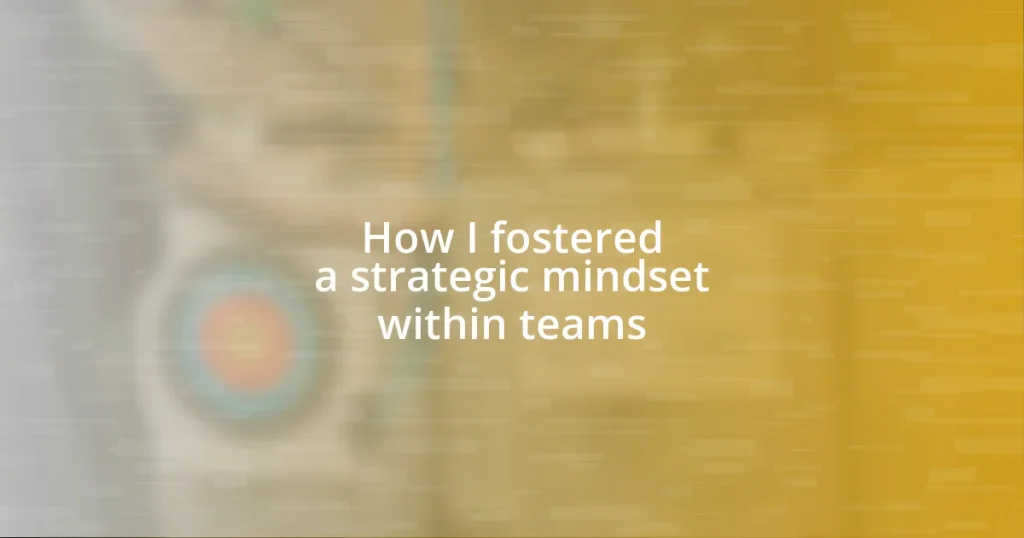Key takeaways:
- Encouraging a strategic mindset involves fostering a culture of open communication and collaborative problem-solving, where team members feel safe to share ideas and explore solutions together.
- Identifying team strengths and weaknesses through regular performance reviews and feedback promotes trust, clarity, and targeted skill development, enhancing overall team performance.
- Setting clear strategic goals and adapting strategies based on quantitative metrics and qualitative feedback cultivates a resilient team that embraces change and continuous improvement.

Understanding strategic mindset
A strategic mindset goes beyond simple planning; it involves anticipating future challenges and opportunities. I remember a project where my team faced unexpected hurdles. By fostering a culture of strategic thinking, we reframed setbacks as learning experiences, which ultimately led us to innovative solutions.
When I think about a strategic mindset, it brings to mind the ability to connect the dots between immediate tasks and long-term goals. Have you ever experienced a moment when a seemingly insignificant decision turned out to have a profound impact? That’s the essence of strategic thinking – it’s about seeing the bigger picture while meticulously attending to the details of daily operations.
In my experience, encouraging team members to embrace a strategic mindset means creating an environment where questions are welcomed. I’ve seen teams thrive when they feel empowered to ponder “what if” scenarios or explore potential outcomes. This approach not only boosts engagement but also sparks creativity, allowing everyone to contribute to collective success.

Importance of strategic thinking
Strategic thinking is vital for any team aiming for long-term success. I recall a specific scenario where my team was under pressure to deliver a project rapidly. Instead of rushing through the tasks, we paused to think strategically about the impact of our decisions. This shift in mindset allowed us to allocate resources better and prioritize effectively, enhancing our overall output without compromising quality.
It’s fascinating how strategic thinking fosters resilience. I once faced a setback due to an unforeseen market change. By analyzing the situation through a strategic lens, my team and I identified new opportunities that transformed a potential failure into a launching pad for growth. The emotional payoff was profound; it reminded everyone that every challenge holds the seed of innovation if approached strategically.
Moreover, a strategic mindset cultivates collaboration among team members. When discussing our goals, I often encourage my colleagues to share their perspectives and ideas. This democratic approach not only enriches our strategies but also strengthens our bond as a team. In the end, strategic thinking isn’t just about outcomes; it’s about the shared journey toward those outcomes, filled with insights and mutual growth.
| Aspect | Impact of Strategic Thinking |
|---|---|
| Decision Making | Enhances foresight and clarity |
| Adaptability | Fosters resilience in changing environments |
| Collaboration | Encourages diverse perspectives and teamwork |

Identifying team strengths and weaknesses
Identifying the strengths and weaknesses of a team is crucial for fostering a strategic mindset. One effective method I’ve used is conducting regular performance reviews. In these sessions, we reflect on individual contributions and collective outcomes. It’s often enlightening to see how team members perceive their strengths. Interestingly, I’ve noticed that some individuals are unaware of their impactful skills, which only come to light through open dialogue.
- Utilize peer feedback to uncover hidden talents.
- Encourage team members to share their personal achievements.
- Analyze past project outcomes to identify areas for growth.
In my experience, acknowledging weaknesses is just as vital as highlighting strengths. I once led a team that struggled with communication, and we took the time to discuss this openly. This candid approach not only built trust but also paved the way for targeted training sessions. Addressing our flaws together fostered a unified vision, enhancing our overall performance.
- Initiate conversations around challenges without judgment.
- Implement anonymous surveys to gather honest input.
- Create action plans focused on skill-building in identified areas.

Setting clear strategic goals
Setting clear strategic goals is foundational for any high-performing team. During one project, we found ourselves at a crossroads, unsure whether to pursue two promising paths. I gathered everyone for a brainstorming session and guided them through a discussion focused on our long-term vision. The clarity that emerged from that conversation not only unified our direction but also sparked an intense enthusiasm among team members to work toward those specific goals.
I’ve come to realize that clarity in goal-setting isn’t just about achieving targets; it’s about creating a shared sense of purpose. I often ask my teams, “What does success look like for us?” This question prompts rich discussions that can unearth varying perspectives and aspirations, aligning our efforts toward a common destination. It’s amazing how a simple dialogue can ignite passion and focus, transforming an ambitious goal into a collective mission.
To truly foster a strategic mindset, I encourage my teams to break larger goals into actionable, measured steps. I remember a time when one of my teams struggled with a vast project. We redefined our main objective into smaller milestones, celebrating every achievement along the way. This approach not only reduced overwhelm but also built a momentum that kept motivation high. What I learned is that even the most daunting goals become achievable when you’re willing to simplify and celebrate the journey together.

Fostering open communication channels
Creating open communication channels within a team is pivotal to nurturing a strategic mindset. I remember a particular team meeting where I encouraged everyone to voice their ideas without the fear of judgment. It was inspiring to witness how a single invitation to share transformed the atmosphere from reserved to vibrant. Have you ever noticed how quickly ideas can flow when people feel safe? That day, we unearthed innovative solutions that I knew we wouldn’t have discovered otherwise.
To further strengthen these channels, I introduced an informal “open door” policy. This wasn’t just a physical gesture; it was about cultivating an environment where team members felt empowered to approach me anytime. I recall a moment when a junior staff member nervously came to discuss a concern that had been bothering them. Not only did that conversation help resolve the issue, but it also led to a significant improvement in our project workflow. It’s incredible what can happen when communication is prioritized.
Moreover, I’ve found that leveraging technology can greatly enhance open communication. In one of my teams, we used collaboration tools for daily check-ins, enabling us to share thoughts and concerns in real time. This practice not only kept everyone updated but also fostered a sense of community, even when we were physically apart. I believe that when people feel connected, they are more willing to engage and contribute to the collective vision. Isn’t it amazing how simple adjustments can lead to deeper connections and greater creativity?

Encouraging collaborative problem solving
Encouraging collaborative problem solving has been a game changer in my teams. I fondly recall a tense moment in a project where we faced a significant setback. Instead of pointing fingers, I facilitated a reflective session that aimed to ‘collectively solve’ rather than ‘individually blame.’ The shift in attitude was palpable. It felt liberating for everyone to contribute their thoughts without the weight of judgment hanging over them, fostering a true spirit of collaboration. Have you ever experienced that moment when a team truly comes together? It’s electric!
One method I integrate is the “reverse brainstorming” technique, where we explore how to create problems instead of solve them. This quirky approach always seems to spark laughter and a flurry of ideas. I remember a day when a team member suggested, “Let’s make the product worse!” As absurd as it sounds, this prompted a wave of insightful feedback on what we needed to improve. It makes me think—how often do we allow creativity to thrive by flipping the script? Embracing unconventional methods can unlock hidden potential.
Moreover, I find that allowing space for diversity in problem-solving perspectives is crucial. During one workshop, I intentionally mixed teams of different backgrounds and expertise. The varied insights bubbled up to create comprehensive solutions that none of us expected. It’s fascinating how our differences can be our greatest strength. When everyone contributes their unique perspectives, we’re not just solving problems; we’re deepening our connections and building a more resilient team. How can we create more opportunities for these moments to flourish?

Measuring progress and adapting strategies
Measuring progress in a strategic mindset involves both quantitative metrics and qualitative feedback. I remember implementing regular check-ins to gauge not just the project status but also team sentiment. It was revealing to hear, at times, that even when progress seemed tangible on paper, there was an undercurrent of frustration that needed addressing. Have you ever sensed that something wasn’t quite right despite the numbers looking good? Those heartfelt discussions opened my eyes to the importance of blending data with the human experience.
Adapting strategies is equally crucial. One project I was involved in took an unexpected turn when initial assumptions proved inaccurate. Instead of doubling down, we paused to reassess. This willingness to pivot not only salvaged our timeline but also built trust within the team. I often ask myself, why cling to a plan that isn’t working? Staying flexible allows us to embrace new ideas that can emerge from unforeseen challenges.
Ultimately, the ability to measure progress while being open to change fosters a culture of continuous improvement. I vividly recall a time when feedback from our retrospective meetings led us to alter our workflow significantly. The changes were initially met with resistance, but over time, the team began to see the value. Isn’t it fascinating how a willingness to listen and adapt can transform hurdles into stepping stones?















